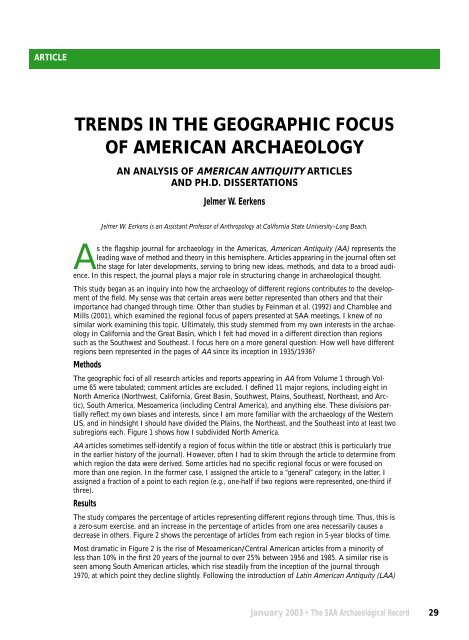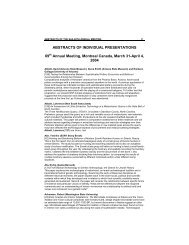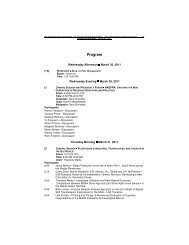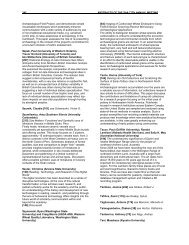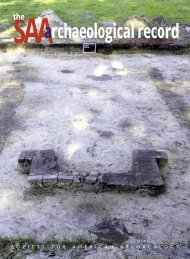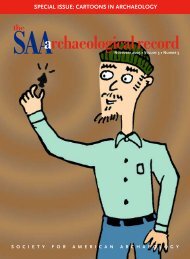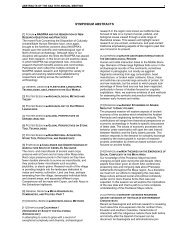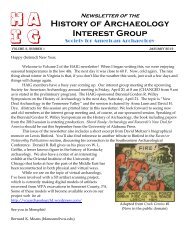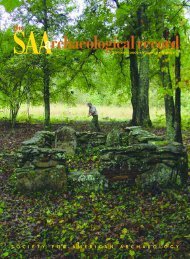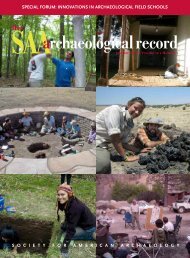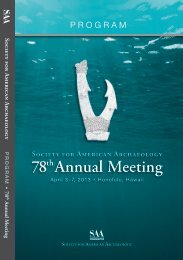The Archaeologist as Storyteller - Society for American Archaeology
The Archaeologist as Storyteller - Society for American Archaeology
The Archaeologist as Storyteller - Society for American Archaeology
You also want an ePaper? Increase the reach of your titles
YUMPU automatically turns print PDFs into web optimized ePapers that Google loves.
ARTICLE<br />
TRENDS IN THE GEOGRAPHIC FOCUS<br />
OF AMERICAN ARCHAEOLOGY<br />
AN ANALYSIS OF AMERICAN ANTIQUITY ARTICLES<br />
AND PH.D. DISSERTATIONS<br />
Jelmer W. Eerkens<br />
Jelmer W. Eerkens is an Assistant Professor of Anthropology at Cali<strong>for</strong>nia State University–Long Beach.<br />
As the flagship journal <strong>for</strong> archaeology in the Americ<strong>as</strong>, <strong>American</strong> Antiquity (AA) represents the<br />
leading wave of method and theory in this hemisphere. Articles appearing in the journal often set<br />
the stage <strong>for</strong> later developments, serving to bring new ide<strong>as</strong>, methods, and data to a broad audience.<br />
In this respect, the journal plays a major role in structuring change in archaeological thought.<br />
This study began <strong>as</strong> an inquiry into how the archaeology of different regions contributes to the development<br />
of the field. My sense w<strong>as</strong> that certain are<strong>as</strong> were better represented than others and that their<br />
importance had changed through time. Other than studies by Feinman et al. (1992) and Chamblee and<br />
Mills (2001), which examined the regional focus of papers presented at SAA meetings, I knew of no<br />
similar work examining this topic. Ultimately, this study stemmed from my own interests in the archaeology<br />
in Cali<strong>for</strong>nia and the Great B<strong>as</strong>in, which I felt had moved in a different direction than regions<br />
such <strong>as</strong> the Southwest and Southe<strong>as</strong>t. I focus here on a more general question: How well have different<br />
regions been represented in the pages of AA since its inception in 1935/1936?<br />
Methods<br />
<strong>The</strong> geographic foci of all research articles and reports appearing in AA from Volume 1 through Volume<br />
65 were tabulated; comment articles are excluded. I defined 11 major regions, including eight in<br />
North America (Northwest, Cali<strong>for</strong>nia, Great B<strong>as</strong>in, Southwest, Plains, Southe<strong>as</strong>t, Northe<strong>as</strong>t, and Arctic),<br />
South America, Mesoamerica (including Central America), and anything else. <strong>The</strong>se divisions partially<br />
reflect my own bi<strong>as</strong>es and interests, since I am more familiar with the archaeology of the Western<br />
US, and in hindsight I should have divided the Plains, the Northe<strong>as</strong>t, and the Southe<strong>as</strong>t into at le<strong>as</strong>t two<br />
subregions each. Figure 1 shows how I subdivided North America.<br />
AA articles sometimes self-identify a region of focus within the title or abstract (this is particularly true<br />
in the earlier history of the journal). However, often I had to skim through the article to determine from<br />
which region the data were derived. Some articles had no specific regional focus or were focused on<br />
more than one region. In the <strong>for</strong>mer c<strong>as</strong>e, I <strong>as</strong>signed the article to a “general” category; in the latter, I<br />
<strong>as</strong>signed a fraction of a point to each region (e.g., one-half if two regions were represented, one-third if<br />
three).<br />
Results<br />
<strong>The</strong> study compares the percentage of articles representing different regions through time. Thus, this is<br />
a zero-sum exercise, and an incre<strong>as</strong>e in the percentage of articles from one area necessarily causes a<br />
decre<strong>as</strong>e in others. Figure 2 shows the percentage of articles from each region in 5-year blocks of time.<br />
Most dramatic in Figure 2 is the rise of Mesoamerican/Central <strong>American</strong> articles from a minority of<br />
less than 10% in the first 20 years of the journal to over 25% between 1956 and 1985. A similar rise is<br />
seen among South <strong>American</strong> articles, which rise steadily from the inception of the journal through<br />
1970, at which point they decline slightly. Following the introduction of Latin <strong>American</strong> Antiquity (LAA)<br />
January 2003 • <strong>The</strong> SAA Archaeological Record<br />
29


